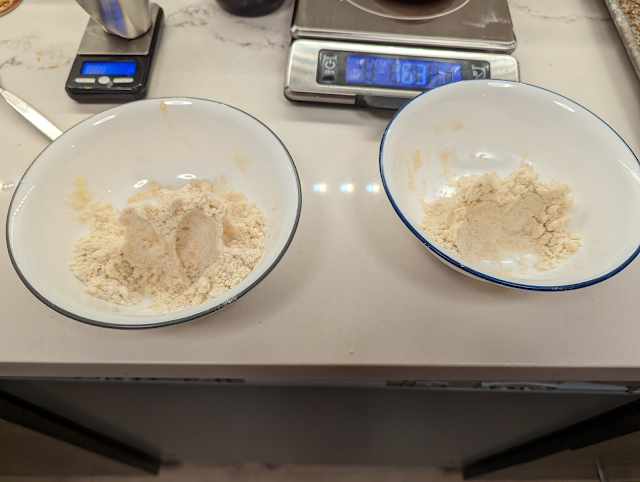Over the last few years, I was asked a few times for information on the origin of
mooncakes. Alas, they don't seem to show up in recipe books as such until quite recently. There's enough evidence to point to them being wrapped in a shortbread-style dough, and indeed modern recipes are as well, usually a combination of flour, sugar syrup, a fat, and sometimes a small amount of alkali.
We do have some shortbread recipes. Qimin Yaoshu (544 CE, northern Wei) has one:
髓餅法:To Make Marrow Cakes
以髓脂、蜜,合和麵。
| Take marrow fat, honey, and mix with flour. |
厚四五分,廣六七寸。
| Make them four or five fen [9.7-12.1 mm] thick, and six or seven inches [14.5-16.9 cm] wide. |
便著胡餅鑪中,令熟。 | When ready, put in a western-barbarian cake oven until cooked. |
勿令反覆。 | Do not flip. |
餅肥美,可經久。 | If the fat is good, they will keep a long time. |
"Western-barbarian" refers vaguely to Central Asia, Parthia, and Persia. This is probably a covered ceramic device that goes over a heat source, perhaps similar to a Roman clibanus.
A Song dynasty recipe from Madam Wu's cookbook (which has a lovely translation published last year and you should go buy it because it is quite good and has all the pickles you could ever need and some you do not because they are made out of lead) is similar, calling for 640g flour, 160g butter, 40g honey, and cooking on a "stove." Lard and doubling the honey is offered as an alternative recipe.
This recipe is 16 : 4 : 1 flour : fat : honey.
There are two recipes from Yuan dynasty Essential Arts for Household Living. These are rough translations, with some awkward parts that I didn't dig into to polish:
599 | 肉油餅 | Meat-Oil Cakes |
600 | 白面一斤。熟油二兩半。豬羊脂各二兩剁碎。酒一小盞與面同和。如硬。入羊骨髓。分作十劑捍開包餡。用托子印花樣。入爐煿熟。筵席上。大者每分供二個。小者供四個。餡與饅頭生餡同。或者供素食蜜穰餡棗穰亦可。 | Join with the flour and mix well. Make it stiff. Add sheep bone marrow. Separately, make ten mixed protected fillings. Press a flower-shaped mold against them in your palm. Put in an oven until cracked and cooked. Place on a bamboo mat. If they are large, serve two at a time. If they are small, serve four at a time. Stuff with the same fresh filling as mantou, or for a vegetarian option, use a honey-seed filling, or a jujube-seed filling. |
601 | 酥蜜餅 | Honey Shortcakes [lit. butte[ry] honey cakes] |
602 | 面十斤。蜜三兩半。羊脂油春四夏六秋冬三兩。豬脂油春半斤。夏六兩。秋冬九兩。溶開傾蜜攪勻。澆入面搜和勻。取意印花樣。入爐熬紙襯底慢火煿熟供 | Ten jin of flour Three and a half liang of honey Sheep/goat fat-oil [melted fat? Specific kind of fat unspecified]: 4 liang in spring, 6 in summer, 3 in fall and winter [melted?] Lard: half a jin in spring, 6 liang in summer, nine liang in fall and winter
Clarify out the honey and pour it. Stir well, and pour it into the flour, soaking it. Mix together well, and then put it in a mold with a meaningful flower design, put it in a stove, and roast on top of a paper lining on a slow fire. When it [cracks, pops, bursts, swells] it is done. Serve it forth. |
It's neat to see fillings here! These are also pretty similar. The first has a 16 : 4.5 : 1 ratio, and the second is 160 : 12 : 3.5, or, normalizing, 46 : 3.4 : 1. This is a much more floury recipe.
You'll note that none of these include water.
Modern mooncake recipes are roughly in the ballpark of 4:1 flour to fat, and typically use sugar syrup, which isn't directly comparable to the honey because I don't feel like doing the math. Western shortbread recipes may not add water, but they usually have a higher ratio of butter, which contains water. Another reference point is modern Central and Western Asian pastries like maamoul, which have water added and are often yeast-raised.
I wanted to try out a few variants to understand the unknowns
- Do I add water, or not?
- Do I add the fat hot, or cold and rub it in?
- Should I use butter, or ghee? (I don't eat meat, so marrow and lard are out, but if you try them, write in!)
- As a result, I made 8 variants using an aeropress as my mold. For each, I used a 16:4:1 flour : fat : honey, with 1 being 5g, giving the following proportions
- 40g flour
- 10g fat
- 2.5g honey
- If called for, 4g water
Recipe steps:
- Blend all ingredients
- Press into cakes as firm as possible
- Pop out of mold, and place on baking sheet
- Bake at 350 degrees (I'm using a "convection bake" setting that will use a slightly lower temperature but have convection) until browned and cracks show on the surface (1 hour)
The dry cookies were basically sand, but did hold a shape after pressing hard. It surprised me that they actually firmed up into something hard! With 4g water, the dough was just barely holding together, which was what I expected from shortbread.
All photos follow the arrangement from the one with labels on it.


|
| No water | Minimal water |
Hot | Butter | Aggressively dry, unpleasant. Holds together and then crumbles to fine powder. Nutty, buttery flavor, lightly sweet | More structure, not astringent. Still dry though. Crack into chewable. Less nutty. |
Ghee | Even drier. Similar, but less nutty. Fine, hard crunch. | A little unpleasantly dry, but pleasant. Similar to hot wet butter |
Cold | Butter | Also very dry, finer texture than hot fat version. Less nutty. | Softer and less shattery than hot wet butter. Very pleasant. |
Ghee | Same as cold butter but with the hot ghee as its reference point | Very similar to hot wet ghee |
I've concluded that I do not wish to eat the no-water-added cookies. They actively sucked water out of my mouth.
To quote my partner on tasting them, "what is this cinnamon challenge bullshit?"
I also don't think you could make them into a filled mooncake. They're too crumbly:
Left: no water, pinched to shape. Right, water added, pinched to shape
This shape is also too thick, really. Thinner and they would be more pleasant: this matches what some other folks trying out this style of cookie have found.
I don't have a strong opinion on the other four variables. The cold fat feels a bit more like a Western shortbread, and some of the recipes call for hot fat, so maybe that's a reason to prefer hot fat, but it's not as strong. I could tell the ghee versions were drier, but if you're adding water that's easy to adjust for.
Coming up with a complete recreation of this recipe has more work in it: what kind of flour? What kind of oven? What's the right texture? Size? Mold type? But I'm glad to have worked out one variable.

All images are also released under this license except as noted.








Comments
Post a Comment